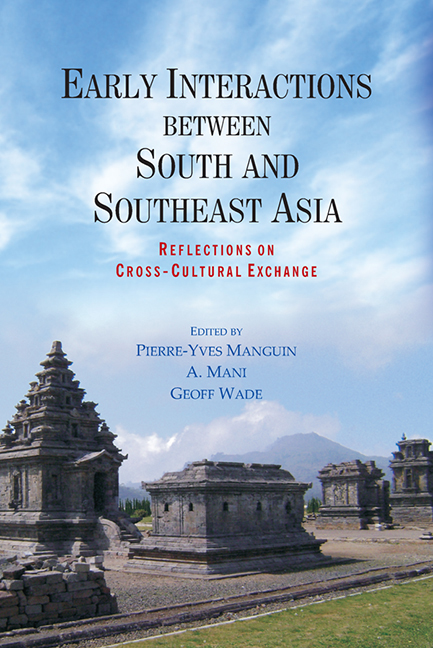Book contents
- Frontmatter
- Contents
- FOREWORD
- Preface
- Introduction
- PART I New Archaeological Evidence from South Asia and Southeast Asia
- PART II Localisation in Southeast Asia
- 11 Tamil Merchants and the Hindu-Buddhist Diaspora in Early Southeast Asia
- 12 The Spread of Sanskrit in Southeast Asia
- 13 The Early Inscriptions of Indonesia and the Problem of the Sanskrit Cosmopolis
- 14 Indian Architecture in the ‘Sanskrit Cosmopolis’: The Temples of the Dieng Plateau
- 15 The Importance of Gupta-period Sculpture in Southeast Asian Art History
- 16 Individuals under the Glaze: Local Transformations of Indianisation in the Decorative Lintels of Angkor
- 17 Early Musical Exchange between India and Southeast Asia
- 18 Buddhism and the Circulation of Ritual in Early Peninsular Southeast Asia
- 19 Early Buddhism in Myanmar: Ye Dhammā Inscriptions from Arakan
- 20 Hindu Deities in Southern Vietnam: Images on Small Archaeological Artefacts
- 21 ‘The Depositing of the Embryo’ – Temple Consecration Rituals in the Hindu Tradition of South and Southeast Asia: A Study of the Textual and Archaeological Evidence
- 22 Localisation of Indian Infl uences as Refl ected in the Laotian Versions of the Ramayana
- 23 Broken Threads: Contested Histories of Brahminism in Cambodia and Thailand and the Construction of Ritual Authority
- LIST OF CONTRIBUTORS
- INDEX
23 - Broken Threads: Contested Histories of Brahminism in Cambodia and Thailand and the Construction of Ritual Authority
from PART II - Localisation in Southeast Asia
Published online by Cambridge University Press: 21 October 2015
- Frontmatter
- Contents
- FOREWORD
- Preface
- Introduction
- PART I New Archaeological Evidence from South Asia and Southeast Asia
- PART II Localisation in Southeast Asia
- 11 Tamil Merchants and the Hindu-Buddhist Diaspora in Early Southeast Asia
- 12 The Spread of Sanskrit in Southeast Asia
- 13 The Early Inscriptions of Indonesia and the Problem of the Sanskrit Cosmopolis
- 14 Indian Architecture in the ‘Sanskrit Cosmopolis’: The Temples of the Dieng Plateau
- 15 The Importance of Gupta-period Sculpture in Southeast Asian Art History
- 16 Individuals under the Glaze: Local Transformations of Indianisation in the Decorative Lintels of Angkor
- 17 Early Musical Exchange between India and Southeast Asia
- 18 Buddhism and the Circulation of Ritual in Early Peninsular Southeast Asia
- 19 Early Buddhism in Myanmar: Ye Dhammā Inscriptions from Arakan
- 20 Hindu Deities in Southern Vietnam: Images on Small Archaeological Artefacts
- 21 ‘The Depositing of the Embryo’ – Temple Consecration Rituals in the Hindu Tradition of South and Southeast Asia: A Study of the Textual and Archaeological Evidence
- 22 Localisation of Indian Infl uences as Refl ected in the Laotian Versions of the Ramayana
- 23 Broken Threads: Contested Histories of Brahminism in Cambodia and Thailand and the Construction of Ritual Authority
- LIST OF CONTRIBUTORS
- INDEX
Summary
One of the major imports to early Southeast Asia from India was religion: specifically, Buddhism and Hinduism. In particular, the Hindu religion (Brahminism) established the cosmological and political legitimisation of kingship in the courts of Southeast Asia. The ‘brahmins’ who preside over court rituals in contemporary Cambodia and Thailand are said to be direct descendants of Angkorian ‘brahmins’, but this identification is highly contested. By Indian definition and from a ritual perspective, the term brahmin generally referred to those whose caste and gotras (ritual lineage) go back to the Vedic period. Scholars of ritual and religions have questioned whether the ‘brahmins’ of Southeast Asia were ‘brahmins’ by the Indian definition, and if so, in what sense. Was there a caste system in ancient Cambodia?
This paper will address the debate and ask what information about ritual and what religious criteria are needed in order to evaluate the status of these so-called ‘brahmins’ in ancient Cambodia. My agenda here is not to reveal the illegitimate status of these so-called ‘brahmins’ but to provide alternative explanations for the construction of ritual authority, and to determine who has the power to define and to legitimise the social status of ‘brahmins’ in local contexts.
NATIONAL NARRATIVE ACCORDING TO NATIONAL GEOGRAPHIC MAGAZINE
A series of narrative paintings was featured in the March 1960 issue of National Geographic Magazine. These paintings accompanied an article written by W. Robert Moore, Chief, Foreign Editorial Staff, entitled, ‘Angkor, Jewel of the Jungle’. The paintings, by Maurice Fiévet, a French artist, provide a visual, chronological narrative of the history of ancient Cambodia from the founding of Angkor in CE 802 to the collapse of the Khmer empire in CE 1431. The most conspicuous aspect of the juxtaposition of text and image is Moore's apparent efforts to present the events depicted in Fiévet's paintings as ‘fact’ rather than fiction. For instance, the opening statement reads:
A many-time visitor to Angkor's ruins and keen student of Khmer culture, the author links his 35 years of research with remarkable paintings by Maurice Fiévet … recreating the daily life of this lost civilisation. The talented artist's drawings underwent minute scrutiny for accuracy by Bernard [Philippe] Groslier and George Coedès, French scholars who have devoted years to unraveling Angkor's riddles.
- Type
- Chapter
- Information
- Early Interactions between South and Southeast AsiaReflections on Cross-Cultural Exchange, pp. 461 - 482Publisher: ISEAS–Yusof Ishak InstitutePrint publication year: 2011



